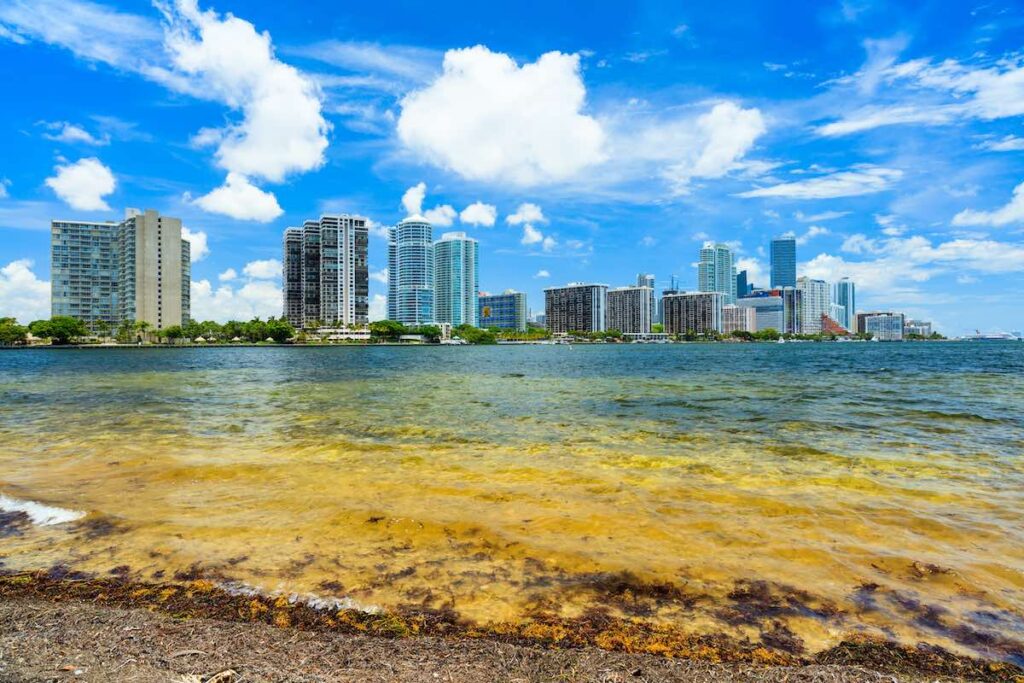No products in the cart.
Travel Guide
Record Amount Of Seaweed Washing Up On Miami Beaches
Last Updated
Tons of sargassum seaweed have been invading the most popular beaches, including top destinations like Cancun and Puerto Rico, and ruining travelers’ vacations— or at least their beach expectations.
These algae have also arrived in South Florida. Miami Beach has been one of the places where the sargassum has covered its white sand and pristine water, annoying tourists with its smell and unpleasant presence.

Only in June, more than 24 tons of this seaweed were collected across the Atlantic coast, a record high compared to the previous year.
NBC News Channel interviewed beachgoers in Miami that weren’t impressed by the sargassum. Tana Suarez had spent some time on the beach this week and tried to swim but said: “It’s all over the place. We tried to go farther but the farther you get the more seaweed you’re gonna get all over.”

Gigi Rodriguez, another frequent visitor said: “I’ve never seen it like this. Never.” Seasonal seaweed has been reaching the coast of Florida for a long time and has been significantly growing since 2011, but it has considerably increased its size and presence this year.
The large amounts of sargassum across the Atlantic have been causing concern among authorities and experts worldwide.
What Travelers Must Know About Seaweed In Miami

The Miami-Dade county recently published guidelines and relevant information about the sargassum seaweed on their official website. These are the most important facts and recommendations for travelers:
- Seaweed season in Miami is from March through October.
- Coastal areas worldwide experience two tides per day. The second tide arrives in the afternoon and, if there is wind, it can bring the seaweed to the shoreline.
- Authorities and workers at Miami-Dade Parks tackle the sargassum very early in the morning before beachgoers arrive. So, if you are in Miami, the best time to go to the beach would be in the morning after the seaweed has been cleaned out.

- According to experts, the great sargassum belt could be the “new norm” and should be expected in the following years. Miami lovers should consider the sargassum season when planning their trips to this fascinating destination.
- The seaweed itself cannot harm people, but small creatures living in it can cause rashes or blisters on the skin. Travelers should avoid touching it.
- When sargassum decomposes it gives off hydrogen sulfide, a substance that smells like rotten eggs and can also irritate the eyes, nose, and throat. Visitors with asthma or breathing illnesses should take precautions although the current levels of hydrogen sulfide at the beach are not considered harmful.

- Special permits are required to manage this seaweed on the beach since it could affect turtle nesting season which takes place during the same period. Before the cleaning operation of the 17 miles of coastline begins every morning, the Miami Dade County Parks’ Sea Turtle team must survey and mark sea turtle nests for their protection.
- The sargassum cannot be removed from the water before it reaches the shoreline. The water is under the jurisdiction of the Department of Environmental Resource Management and the “The Sargassum Fishery Management Plan” approved in 2003 prohibits and limits the seaweed harvest.

- The seaweed removed is transported to a special landfill where it dries and is composted and recycled into fertilizer.
- Radical measures to avoid or remove sargassum from the coastline cannot be taken considering that this seaweed provides crucial habitat for many species including sea turtles.

Travelers must consider these algae when planning their vacations and understand that the sargassum belt is here to stay. It not only affects the coast of Florida. Other destinations like Cancun, Costa Rica, Puerto Rico, the Dominican Republic, and Barbados have beaches covered by this seaweed as well.
It is an international matter and organizations across the world, including the United Nations, are working on sustainable solutions to contain and reduce seaweed growth.

↓ Join the community ↓
The Travel Off Path Community FB group has all the latest reopening news, conversations, and Q&A’s happening daily!

SUBSCRIBE TO OUR LATEST POSTS
Enter your email address to subscribe to Travel Off Path’s latest breaking travel news, straight to your inbox
Disclaimer: Current travel rules and restrictions can change without notice. The decision to travel is ultimately your responsibility. Contact your consulate and/or local authorities to confirm your nationality’s entry and/or any changes to travel requirements before traveling. Travel Off Path does not endorse traveling against government advisories
Source link

